
A Detail Analytical Study of Post Lockdown Effect on Students of Department of Architecture, KUET
The COVID-19 pandemic has affected the whole world, placing every country in a particular state of Lockdown to contain the epidemic. Low pollution levels improved the environment, but this unplanned Lockdown has harmed people's mental and physical health. The pandemic has significantly altered many dimensions, factors, and entities of human existence. People have been fighting against economic, social, emotional, and bodily crises during this Lockdown. People either get frustrated or have more significant potential as the Lockdown lasts longer. We conducted a detailed study to investigate the influence of Lockdown on the students of the Department of Architecture at KUET in terms of behavioural changes. This study aims to determine university students' attitudes and knowledge because the impacts of a lockdown can have consequences on them owing to tension, anxiety, and panic.
RESEARCHEDUCATIONFEATUREDPOST COVID IMPACT
Mahmuda Yasmin Dola
7/21/202221 min read

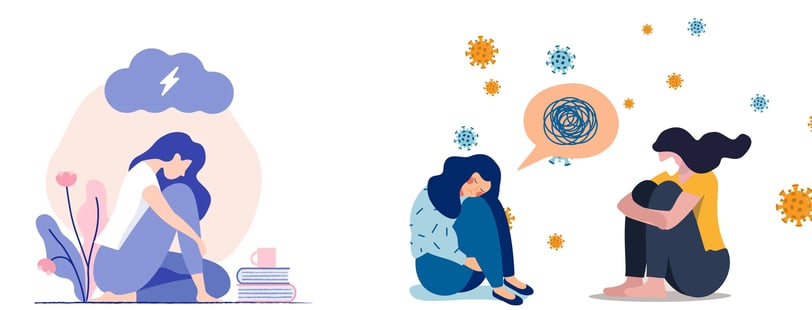

Image: Internet


A questionnaire survey comprising 70 questions was conducted among five batches of undergraduate students at the KUET architecture department. Then, their responses were recorded through a field survey, and SPSS software version 25 was used to analyze the data. In addition, we studied the survey data and concluded the mild changes in students' mental and physical characteristics. Responses were collected randomly for the cross-sectional survey research design used in the study. In total, 50 responses were recorded from architecture department students from various aspects. The study confirmed and represented five significant attributes: academic attributes, economic condition, socio-cultural attributes, family and relationship, and mental and physical health. Again, this study conducted many other behavioural analyses of these attributes to understand the effect of the Lockdown on the attitude of university students.
Chapter 1: Introduction
1.1 Background
It is thought that a viral outbreak started in Wuhan City, central Hubei Province, China, in December 2019 [1]. WHO and the Chinese authorities established that the etiological agent for this virus outbreak was the new virus named novel coronavirus (2019-nCov) [2]. The infection spread worldwide over a few weeks at a rapid pace. By March 11, 2020, the new coronavirus disease had been declared a pandemic; nearly 114 countries were affected (WHO 2020) [3]. Meanwhile, developing and growing nations like Bangladesh may be experiencing worse challenges than developed ones because the pandemic has disrupted and bankrupted many small and medium-sized organizations (SMEs) (Fernandes, 2020). Due to the worldwide Lockdown and severe food and health crises brought on by the COVID-19 epidemic, low-income and middle-income families experienced financial hardships (Banna, 2020). The government also shut down all educational institutions on March 16, halting all current class activities further to flatten the coronavirus curve (Shawon, 2020). The COVID-19 outbreak is the worst public health catastrophe in recent memory and has significantly impacted students' mental and physical health. This effect is felt by students at KUET's Department of Architecture, Khulna, Bangladesh. During a lengthy lockdown, it is unavoidable for students to let their mental health deteriorate. Because of several influencing elements such as online classes, session congestion, and the economic crisis, students' concern about being negatively affected in Covid prompted them to radically alter their attitudes and behavioral entities. Our goal is to survey to investigate the influence of Lockdown and Covid on students' behavioral and mental health at the Department of Architecture, KUET. We will follow a disciplined method to examine the data as precisely as possible. We posed questions on students' academic, economic, socio-cultural, social, mental, and physical crises. We did our best to cover all issues to assist in forecasting and analyzing data at the most appropriate size. Finally, we will use IBM SPSS to do frequency, percentage, mean, standard deviation, crosstabs, data manipulation, and correlation analysis on the data.
1.1 Aim of the study
The study aimed to assess the impacts of Lockdown on the attitude of university students; the social and behavioral pattern analyses dealt with using the software of IBM SPSS.
1.2 Problem statement
University students had inadequate COVID-19 awareness and high-risk perceptions. The study's findings show that many participants desired additional direction and support since they felt unsure about various areas of their online learning experience. Technical issues like a disrupted network and unfamiliarity with the new programs are some causes of this disengagement. Due to the tutors' lack of experience with online teaching and the constraints of peer interaction, the personal circumstances of students and tutors when working and studying from home are also relevant. Consequently, these elements may make using the online design studio more difficult.
1.3 Objective
· Identification of the lockdown effect among various social and behavioral attributes on the attitude of students of the Architecture department of KUET and distance learning.
· Analyzing the root causes and the effects derived from academic attributes, economic condition, socio-cultural attributes, family and relationship, and mental and physical health by cross-sectional survey research design using IBM SPSS version 25 to analyze the survey data.
1.4 Scope of the study
The study has been conducted on the attitude of students of the Architecture department of KUET. The study will identify the significant attitude changes that the students faced during the Lockdown and pick the causes behind the attitude changes in detail. Then point out the derived and root causes of the significant attitude changes, analyze the outcomes of these behavioral changes, and use technology tools to analyze the lockdown attitude changes among students and address the possible adverse outcomes.
1.5 Limitation of the study
The questionnaire sample was taken only from the KUET Department of Architecture and not from other university departments confined to our study. However, to truly acquire new insights, the study could be expanded in the future to include students from other disciplines. Despite the widespread use of self-reporting scales in research, it is possible that "social desirability biases" emerged during data collecting. Again, the survey was constrained to a look at student perceptions and left out the viewpoints of teachers and decision-makers. However, we collected many responses to 70 questions among five batches of undergraduate students at the KUET architecture department and recorded them through a field survey.
Chapter 2: Literature Review
The outbreak and the subsequent Lockdown interrupted and impacted the world's educational system (Vu et al., 2020), with adverse effects on students, teachers, and educational institutions (Mailizar et al., 2020). Due to the pandemic-related stoppage of academic activity, students have experienced significant educational delays. A study of the knowledge and perception of COVID-19 among 305 Rajshahi University students in Bangladesh was conducted more recently by Wadood et al. (Wadood et al., 2020). According to the researchers, the students' knowledge of COVID-19 was poor, and their views on its effects were similarly subpar. According to a different study done in India, healthcare professionals and students know about the coronavirus disease (Modi et al., 2020).
Additionally, Bangladeshi students lack a thorough comprehension of COVID-19 compared to Indian students, professionals, and non-medical employees (Wadood et al., 2020). This might be ascribed to the discontinuation of in-person instruction and disruption of academic programs brought on by the closing of educational institutions (Jacob et al., 2020). Besides, delays in reopening higher education institutions will worsen their psychological state and academic growth (Chandasiri, 2020).
In South India, cross-sectional observational research was also conducted. It was sampled using a snowball method. A consent form was attached to an online semi-structured questionnaire containing closed-ended questions using Google Forms. The questionnaire was pretested among a small group of students inside an institution and validated by three experts in the professor cadre to determine the level of understanding of the questions. The Google Forms survey, which included 15 questions on how the students felt about the pandemic lockdown, was distributed to university students via email, Facebook, and numerous social media platforms, including WhatsApp. The contacts passed the link forward to their friends and contacts, who then passed it along to their friends and contacts, creating a snowball effect. The provided responses were collected, and SPSS software version 17 was used for statistical analysis.
The information gathered from the questionnaire survey was used to calculate the frequency, percentage, mean, standard deviation, and p-value. Students at universities were given access to the online questionnaire survey. University students from the departments of medicine, dentistry, engineering, and other faculties like the arts and science stream, provided a total of 1241 responses. Among the faculties, 66 % of respondents were from the faculty of dentistry, 21 % from the faculty of medicine, 7 % from other faculties, and 6 % from the faculty of engineering.
Chapter 3: Methodology and Study Design
3.1 Sampling
In this study, the KUET architecture department was selected as the sampling site, and five batch students were selected randomly as a respondent sample. A total of 50 students among 31 male and 19 female students were invited to participate in this field survey assessment. Their age range was 22–24 years. Seventy questions were selected to conduct the field survey. The questionnaire was anonymous (demographic questions were asked but did not include identification details).
3.2 Study Instrument
To measure participant knowledge and opinions regarding the pandemic, we used the COVID-19 General Information Questionnaire. The survey questions were created based on a literature review and informal conversations with 50 architecture students. The questions were introduced via a programmed set of instructions. There was language in these questions stating that there were no right or incorrect responses and that the participants' sentiments or experiences with the investigation's subject matter were to be ascertained. The participants' age, gender, relationship status, and vaccination status were assembled using single-item measurements. Participants were given our word that the study was optional, anonymous, and private.
3.3 Study Method
An exponential non-discriminatory snowball survey methodology was used in this cross-sectional investigation (Goodman, 1961). The study was carried out physically utilizing a questionnaire survey among five batches of the architecture department at KUET in Bangladesh in June 2022. Such physical survey methods were used for a variety of purposes. The ease of finding respondents came first. Additionally, the poll was conducted after the lockout at our department, making it easy to physically collect data using alternative probability methodologies. Additionally, the confidentiality of the respondents' identities was a second factor (QuestionPro, 2020).
Chapter 4: Results and Interpretation
4.1 Social and Demographic Analysis
From Table 1, among 50 participants, about 62% and 38% of participants are male and female, respectively. About 10% of the participants are within the age of 21 years, 34% are 22 years, 24% are 23 years, 26% are 24 years, and the rest 6% are 25 years. Out of 50 students, 6% are second-year students, 38% are third-year students, 32% are fourth-year students, and the rest 24% are fifth-year students. Again among 50 architecture students, 26% of participants were covid affected, while 74% were not affected during the pandemic.
Furthermore, during the Lockdown, the participants' relationship status was about 66% of students were single, 2% married, 18% were in a relationship, and the other 14% of students' relationships were private.
Finally, the most crucial issue was the vaccination status. Among 50 respondents, 52% had taken their booster dose vaccine, 44% had a second dose, and the rest, 4% had taken the first dose.
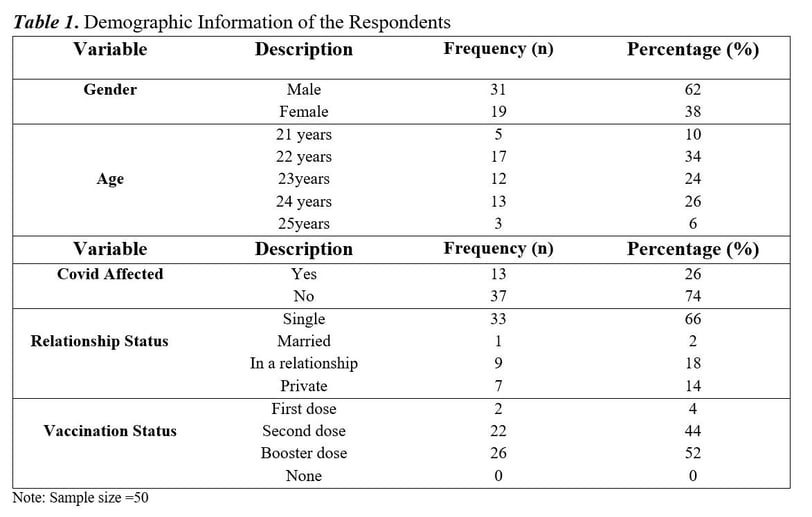

4.2 Student's Attitude and Behavioral Pattern Analysis
We conducted a questionnaire survey of 50 students from different batches in the KUET Architecture Department on their attitude changes regarding the effect of Lockdown. This survey gives us a variety of responses that will later ensure that this kind of pandemic affects our attitude, from which we can take all necessary measures if such an epidemic is seen again soon. We have divided the effect of Lockdown on this attitude change into five attributes – 1. Academic Attributes, 2. Economic Condition, 3. Socio-Cultural Attributes, 4. Family & Relationship, and 5. Mental & Physical Health. This study will help to quickly find out which critical attributes of Lockdown change students' attitudes, and accordingly, we can take necessary measures in the distant future, that is the outcome of this study.
4.2.1 Effects of Lockdown on Academic Attributes
From Table 2,
1. The impact of Lockdown had a significant impact on the academic attributes. As a result, it can be seen that 48% of students in the KUET Architecture Department are of good academic quality. On the other hand, the average student quality is 28%. This is because they used to work a lot in offline systems and sleep less for design studios; that habit made them more efficient during their lockdown time. Because this time, the pressure on the design studio was somewhat less, and since the work of model making did not have to be done, they had more time to improve their skills.
2. On the other hand, 40% of students had class attendance of (70-100)% and attended online classes regularly. Since they do not go out and have previous work habits, which drives them more toward online classes. As a result, the online attendance of 38% of students was (51-70)% and 40% was (71-100)%. It can also be seen that online attendance of only 2% of students was (0-30)%.
3. During Lockdown, they did not have much problem conducting classes for online class resources. Almost 48% of students had access to broadband laptops, 28% had access to mobile data + laptops, another 22% had access to mobile data + Smartphones, and only 2% had no access to any resource. Studying architecture is somewhat more expensive than other departments, and most students know this, so there is no shortage of resources.
4. During the Lockdown, the effect of online classes was responsible for the students' mood swings. 26% of students in this department had a frequent breakdown, 48% had neutral, 14% had a severe breakdown, and the remaining 2% had a positive mental mindset. Because they did not have to do the hard physical work like the design studio in the online class, and they almost did the design work online, and because they gave the theory class, assignment and online CT, there was less pressure on them compared to offline pressure. 48% of the students were in a neutral state, and the reason for the often breakdown of the remaining 26% was seen as various family, economic, and mental instability due to which they were reluctant to attend online classes, which was the cause of their mental breakdown.
5. At the time of Lockdown, 40% of the students had contact with the teachers. Because the activities of the maximum class were understood as online classes and did not have to contact the teacher at different times. The remaining 36% were irregular because they were inattentive in class, attended class, and did other work.
6. Gaining self-skills is a vital issue for architecture students. However, 50% of students still could not gain enough skills during the Lockdown. Many of them suffer from procrastination. Those who are a bit IT savvy have utilized this time, and their rate was 22%. Moreover, 14% are neutral, and the rest, 14%, confidently said their skills had been gained.
7. When an important thing like skill gain is significantly less, it causes much suffering, especially for architecture students. Moreover, 68% of students have a severe breakdown due to little learning. On the other hand, the remaining 32% felt they had learned a lot, which made them mentally stable.
8. In adverse situations like semester clutter and semester lag, 30% of students suffered from severe depression, 40% from mild depression, 20% from neutral, and 10% of the students were able to cope.
9. Due to family support during the Lockdown, 40% of students' sessions dealing with clutter were family-friendly. 40% were neutral, 12% were enthusiastic, and 8% of family members were not cooperative.
10. In the student backwardness situation, 38% of family members understood, 48% were neutral, 12% were encouraged, and 2% were pressured.
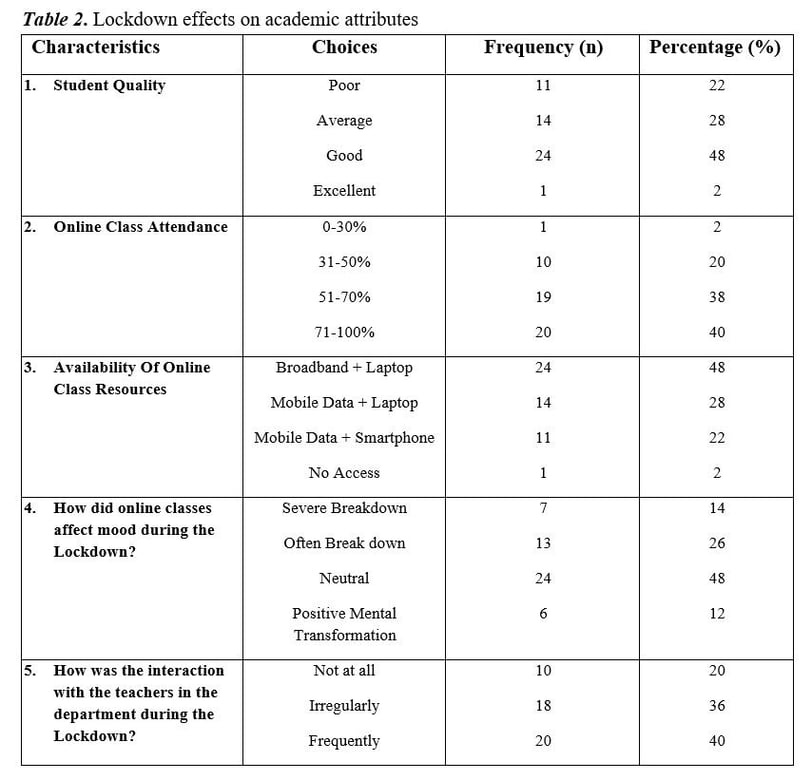

4.2.2 Effects of Lockdown on Economic Condition
From Table 3,
1. At the time of the Lockdown, economic conditions were a significant issue for all students' families. At this time, 36% of families were in neutral conditions, 22% were in moderate, 24% were in awful conditions, and 18% did not affect the family.
2. Economic crisis has many effects on mental conditions. 38% of the students were moderately depressed, 14% were severely depressed, 26% were neutral, and 22% were able to cope.
3. During the Lockdown, many students, especially boys, contributed financially to the family. From the survey, 10% of the students had to bear family expenses, while 46% had to do nothing.
4. Those who have contributed financially to the family have higher self-satisfaction, personality, and social development than others. The same scenario has been seen in the Kuet Architecture Department, where 4% were highly appreciated, 22% were in their respective situations, 68% were in neutral condition, and the remaining 6% were in no position.
5. During the Lockdown, various jobs were attractive to students according to their quality and ability. Where observed, 22% of students preferred skill gain, and 22% preferred money income. On the other hand, 36% of students preferred both, and the remaining 20% preferred neither.
6. Generally, skills gain and work like money income enrich students' post-pandemic life and self-personality. 36% had a mild effect, 26% had a severe effect, 24% had a neutral effect, and 14% had no effect.
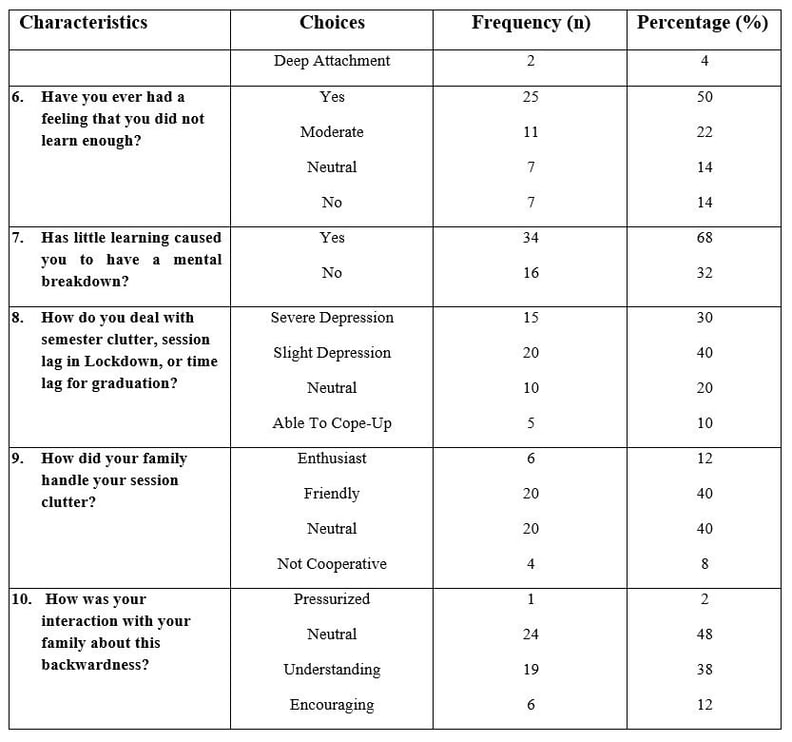

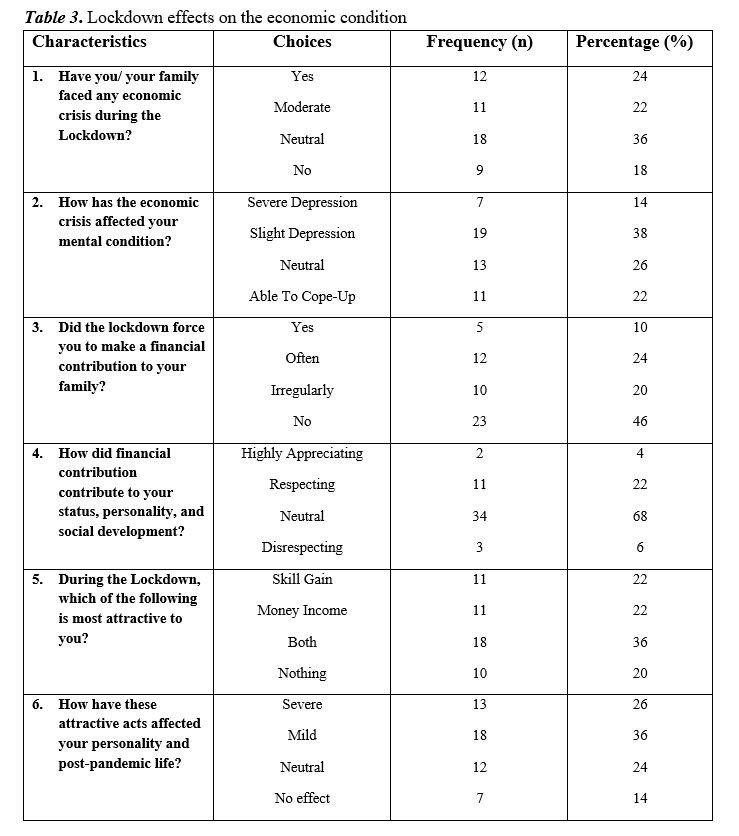

4.2.3 Effects of Lockdown on Socio-Cultural Attributes
From Table 4,
1. Social isolation during the Lockdown had an impact on the students. Due to which 28% of students suffered from severe suffocation, 34% were neutral, 20% moderate, and the remaining 18% enjoyed the lockdown period.
2. The travel habit has dramatically affected the students' life at Lockdown's time. 28% of students stayed at home without any travel. On the other hand, 28% of students were casual about their travel, 22% travelled but were not careful about safety, and the remaining 22% were as usual.
3. Regarding social engagement, 14% of students were engaging, 20% had no social interaction, 30% were moderate, and the rest, 36%, were neutral—their different physical, mental and family situations acted as influencers.
4. Architecture students are very friendly and enthusiastic about their creative work. For which they like to mingle and chat with everyone. Here too, it has been seen that only 4% of the students gave their opinion on the restriction of relatives coming to their house, and 26% of the students had no restriction. On the other hand, 34% and 36% of students said they could come occasionally and often for safety precautions.
5. 6% regularly came to the restaurant, 14% never came, 28% of students were often seen coming, and the rest, 52%, used to come to the restaurant sometimes. The reason for 52% coming is that the students were very fond of food and could not stay in the closed environment at home; they came to the open environment of the restaurant.
6. Among the students who came to the park for health, recreation, and exercise during the Lockdown, 42% of the students sometimes went to the park, and 32% did not go at all; instead, they chose the bus as a safe zone. Moreover, the remaining 26% of students used to go often.
7. The impact of social media was negative on 36% of students. On the other hand, 32% gave a positive opinion, 18% said peaceful, and 14% of students were quarrelsome over the issue. These have mainly varied due to the different perspectives of different students.
8. During this time, much false news was spread, which 60% of students ignored, 22% justified, 12% argued, and the remaining 6% took the matter positively.
9. Many chose this online game to spend their free time where 36% sometimes, 34% often, and 2% regularly play online games. On the other hand, 28% were not addicted to the game.
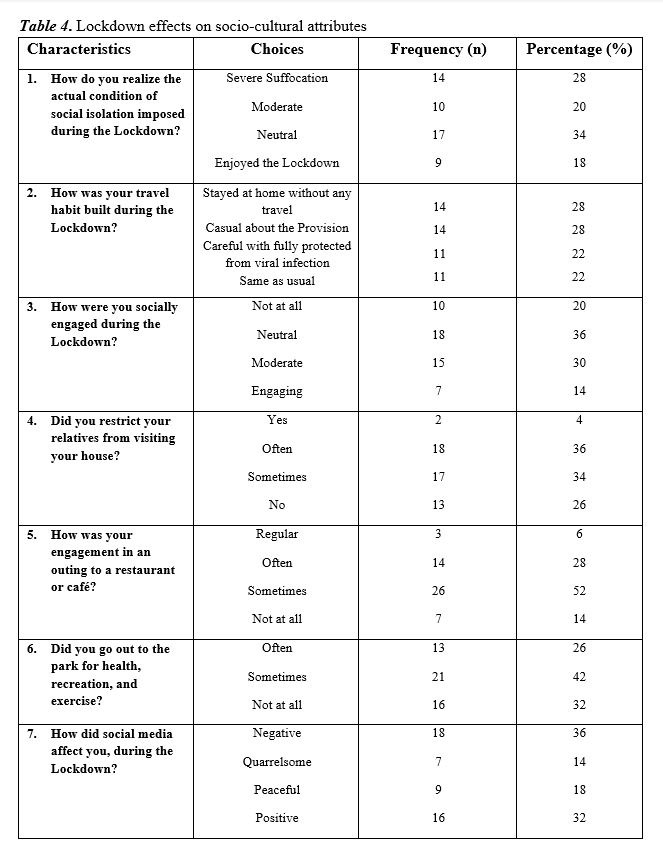

4.2.4 Effects of Lockdown on Family & Relationship
From Table 5,
1. The time spent with family during the Lockdown was a blessing for the students. In the Architecture Department, 58% of students spent quality time with their families. Because most of the students, especially girls, could discuss everything with their families and were motivated. For which attachment was more. On the other hand, 16% were in emotional crisis, 12% were reserved, 8% were quarrelsome, and 6% ignored the family. Most of the families who were reserved and ignored were boys. Those who could not be involved with family due to love relationships, outside tuition, or all other reasons.
2. As seen in the Lockdown, 54% were positive, 26% neutral, 18% de facto, and the remaining 2% were negative regarding family relationships.
3. Due to spending much time in the family during the Lockdown, the mood swings of the students at different times. In terms of preventing mood swings, 32% of the students used to keep themselves quiet, 32% were busy in various activities, watching TV, on social media, 32% doing nothing, and the remaining 4% expressed mood swing issues through crying or laughing.
4. Regarding the effect of mood swings, 52% of students' mood swings sometimes affected their family relationships, 22% often had an impact, 18% had no effect, and the rest, 8%, had a direct impact on their mood swing.
5. Another thing is the love relationship of the students. In this case, 38% were involved in a relationship, 24% had a complex situation, and 38% were single and spent time on themselves and family.
6. Love relationships have both good and bad effects on mental breakdown. In this case, the relationship status of 38% could not prevent mental breakdown, 22% sometimes managed, 18% often managed, and on the other hand, 22% completely managed to prevent mental breakdown. These things depend on each person's personality.
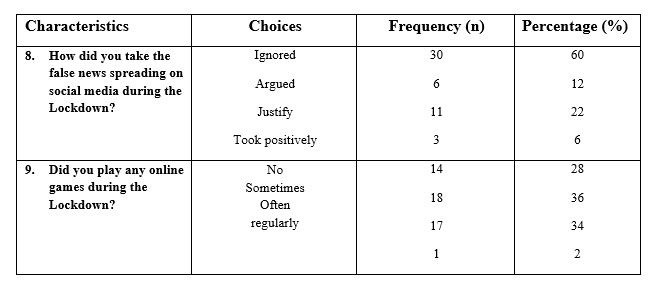

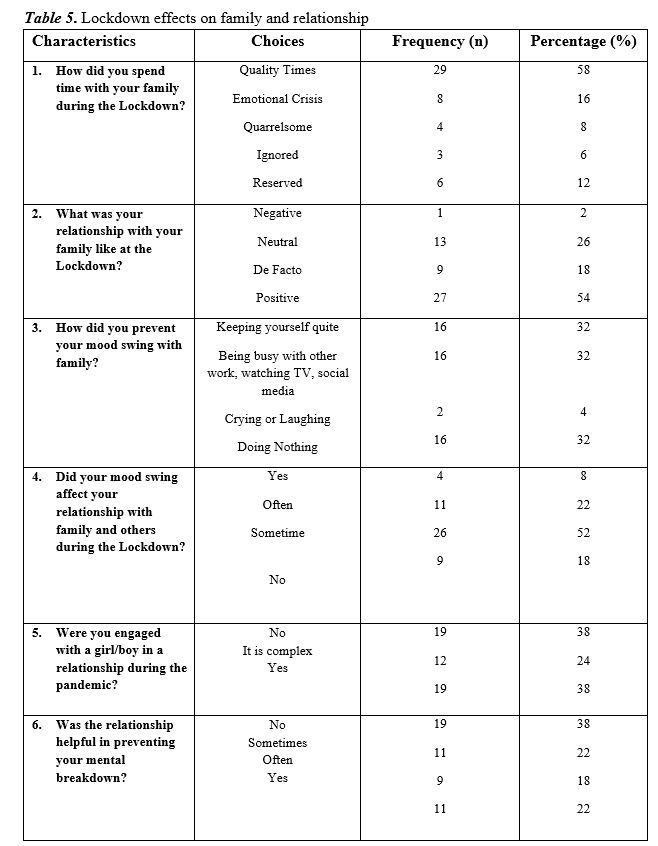

4.2.5 Effects of Lockdown on Mental & Physical Health
From Table 6,
1. The effect of Lockdown has had a great impact on mental and physical health. The fear of getting infected with coronavirus has affected the mental state of the students. Regarding impact, 40% were severe, 42% mild, 20% neutral, 12% de facto and 6% positive.
2. Many people have changed their habits during the Lockdown. As going out was prohibited during this time, social interaction was little, and everything was closed; students got quality time to build various habits. However, in the architecture department, 38% were neutral because they had less free time for online classes and designing. Moreover, because of their chill mind, they used to spend time for recreational purposes instead of habit building. Moreover, 12% built the habit of those who were less organized and could work on time.
3. Lockdown has changed students as people or a whole part of attitude. Where 30% neutral, 28% mild, 18% de facto, 12% positive, and the remaining 12% severely changed.
4. Due to illness and insufficient food stock during Corona, many people have changed their eating habits. It can be seen from the survey that 36% of the students are in a neutral state; they have not changed much. 28% had mild effects, and 10% had severe changes.
5. Changes in eating habits have a terrible effect on physical health. Here also, 34% neutral condition is seen, 28% mild, 22% de facto, 12% positive, and the remaining 4% have severe effects. KUET architecture students are aware of their eating habits and physical health. Moreover, they adopted to handle difficult situations in offline classes, for which they were as usual even in pandemic situations.
6. Along with physical health, there has been a change in mental health during the Lockdown. A maximum 34% of students had a neutral condition, and 10% had a severe change.
7. Many circumstances have an impact on the way of thinking. 20% had a severe change, 34% were neutral, and 12% had a positive way of thinking.
8. The pandemic also affected personal relationships and mental conditions. Where 2% severely, 16% positive, 18% mild, 30% de facto, and the remaining 34% were neutral.
9. Another major impact of the Lockdown was on sleep routines. Looking at changes in sleep routines during this period, 46% had de facto conditions, 26% were neutral, 20% had severe changes, 4% had mild changes and the remaining 4 % had a positive change in sleep routine. Everyone has the experience of working late at night in architecture, for which they were skeptical about their sleep routine despite having plenty of time to sleep during the Lockdown.
10. In the post-pandemic situation, illness makes many people feel weak. Where seen, 34% were de facto, 26% were neutral, 20% were mild, 12% were positive, and the remaining 4% were severely weak.
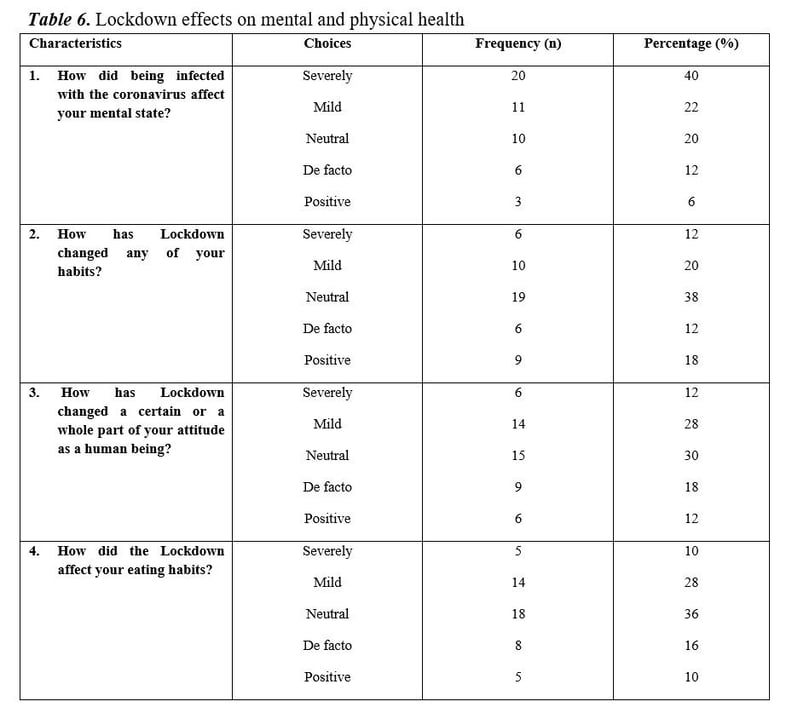

As seen in Table-7 (Figure 1), out of a sample of 50 students during the coronavirus pandemic, 26 or 52% were vaccinated with a booster dose, 22% or 44% with the second dose, and only 2% or 4% with the first dose. First of all, since they are public university students, public awareness activities are more prevalent among them. Many teenagers have taken booster doses because they are aware of their health. Another reason is that the varsity instructed them to give them the corona vaccine, which completed most of the three doses.
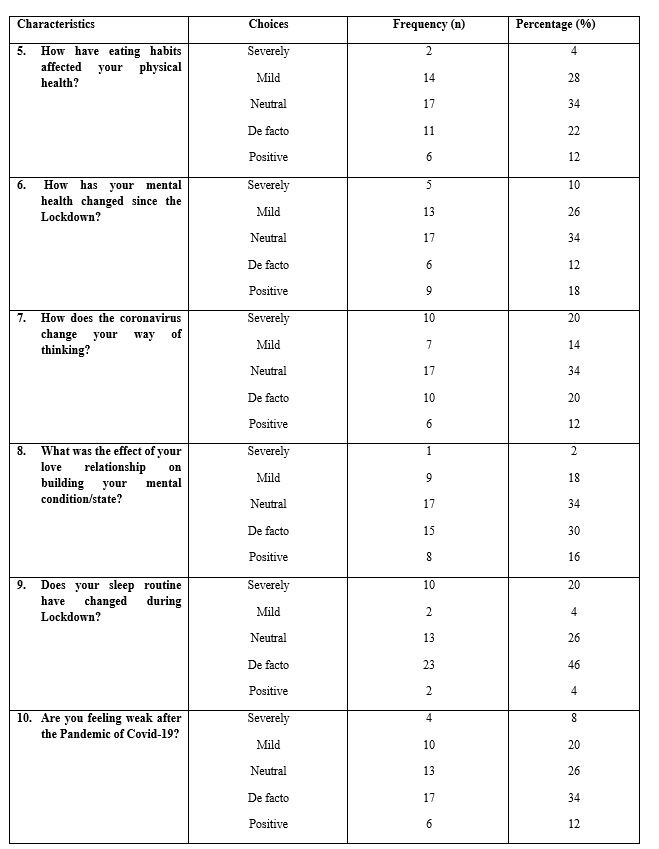

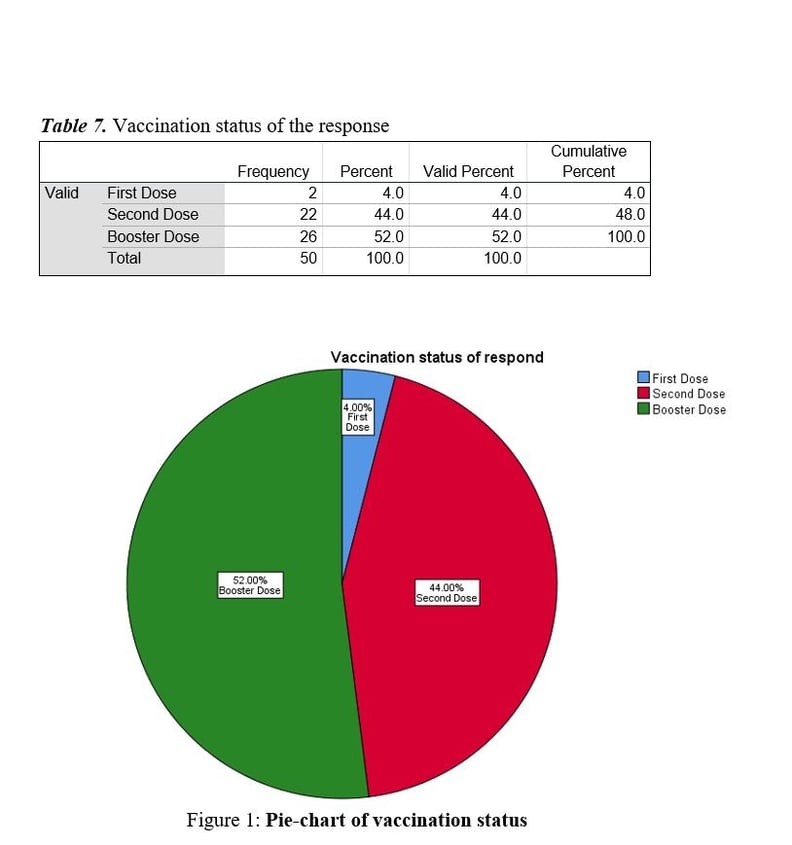

Table 8 (Figure 2) shows that 8% are single, 18% are in a relationship, 6% are in private, and 2% are married students. The reason for having a large percentage of single students is mainly the pressure of design studio and theory classes in architecture. Due to which they did not get involved in any other relationship, they took the relationship as a burden. 8% of students did not want to reveal their relationship; the primary purpose was to keep it private. Many were not stable about their mental and academic problems, for which Relation kept them private. Moreover, in the remaining 18% of students, many are more positive, and another class is indifferent to life. They spent their leisure time building relationships with each other during the Lockdown.
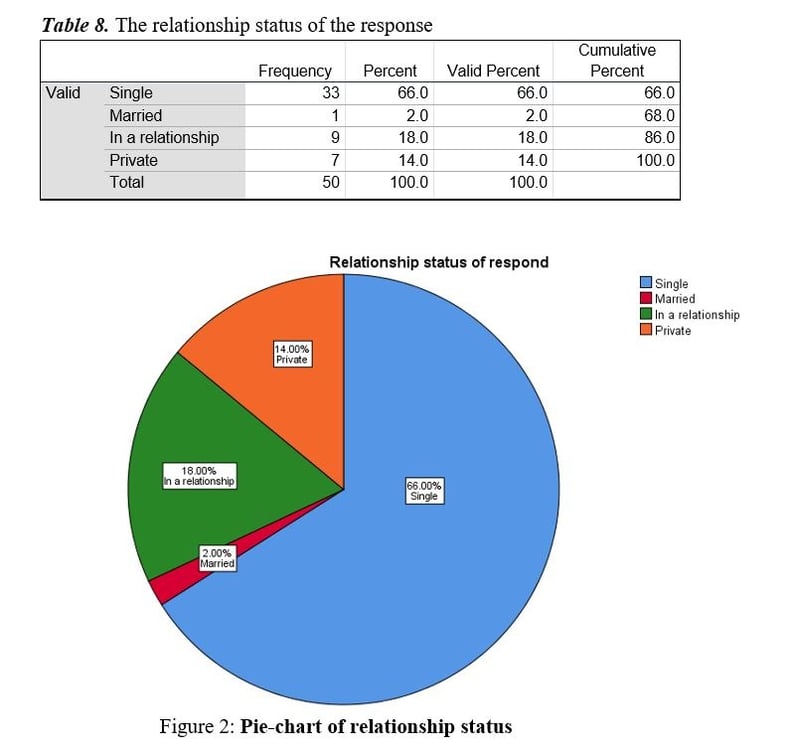

From Table 9 (Figure 3), the availability of online resources was around 48% of students had broadband+laptop access, 28% had mobile data+laptop, 22% had mobile data+smartphone, and 2% had no access to resources during the Lockdown. Almost all students had the resource accessibility to continue their online academic learning. Because architecture is almost a costly subject, many people deliberately prepare to study in this department, and during their first year, everyone buys electronic devices, which is why many of these resources have less of a shortage.
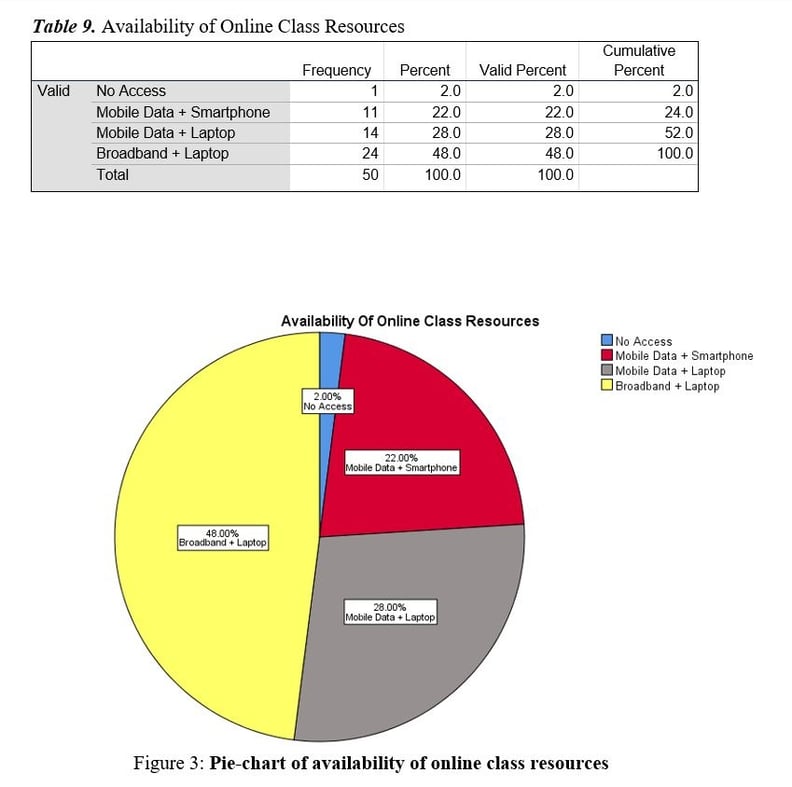

Table 10 (Figure 4) shows a crosstabulation that provides data on COVID-19-affected students of different years and is subsequently illustrated by a bar chart. As it turns out, fifth-year students are more likely to be infected. This is because they are the most senior in the department and are on the verge of leaving the varsity. Because of this, they have many career-related fears and have already gotten out of the earning system like tuition. As a result, they have been infected. Those who are most affected after this are in the third Year. They are chill-minded in everything and have wandered around in various places outside in the intoxication of Project Explore.
On the other hand, the first-year Students barely come to varsity, and it takes them time to cope with everything. Lastly, fourth-year students are not aware enough, and there is no income-related urge for which they were least affected. Due to this, they have confined themselves to their homes.
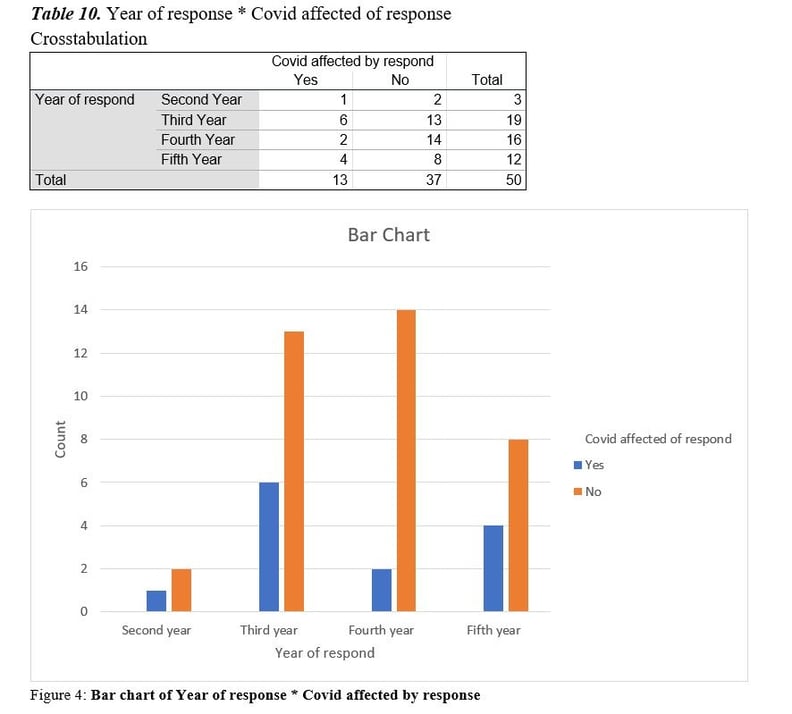

As can be seen from Table 11 (Figure 5), the third and fifth-year students attended the most online classes. Since the third-year students are in the middle stage, they are more interested in learning and knowing. Moreover, since the fifth-year students have come to the last stage, there is a tendency for everyone to do well in academics and handle thesis and big studio design projects, even if they are forced to stay in the online class. On the other hand, the reason for the low attendance in the First Year and Fourth Year is that many first-year students did not join the online class because they did not understand the online curriculum, and a few fourth-year students did not join the class because they did not have many obligations.
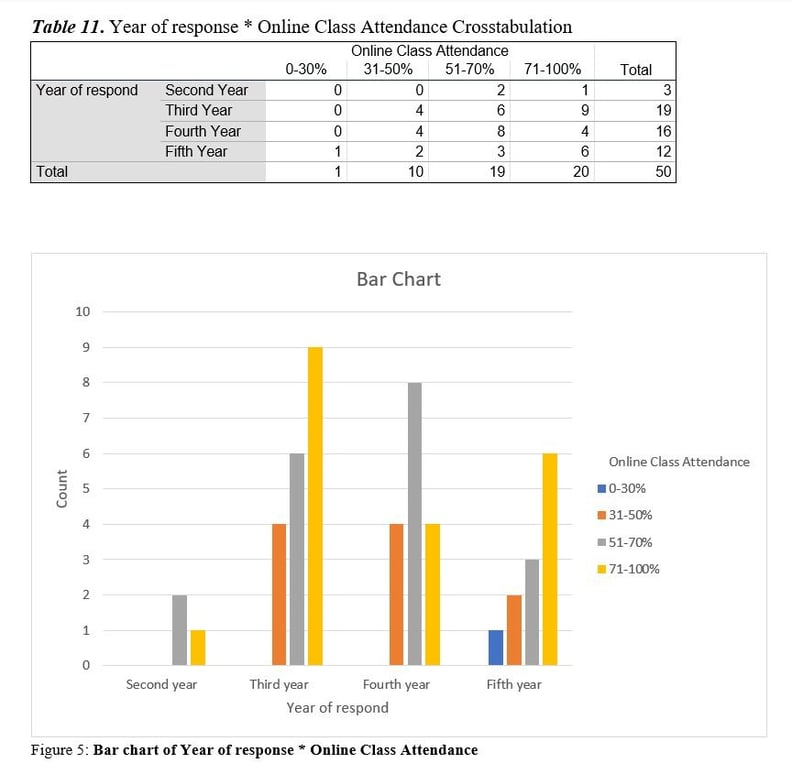

Table 12 (Figure 6), Fifth-year students are more prone to severe depression than the rest of the department. This is because they have been more mentally disturbed since last Year due to the pressure of financial contribution on them. They are also mentally disturbed due to family, financial and personal love relationship problems. On the other hand, the mental condition of the rest of the department has deteriorated, mainly due to the pressure of the studio and the pressure of the non-departmental theory class.
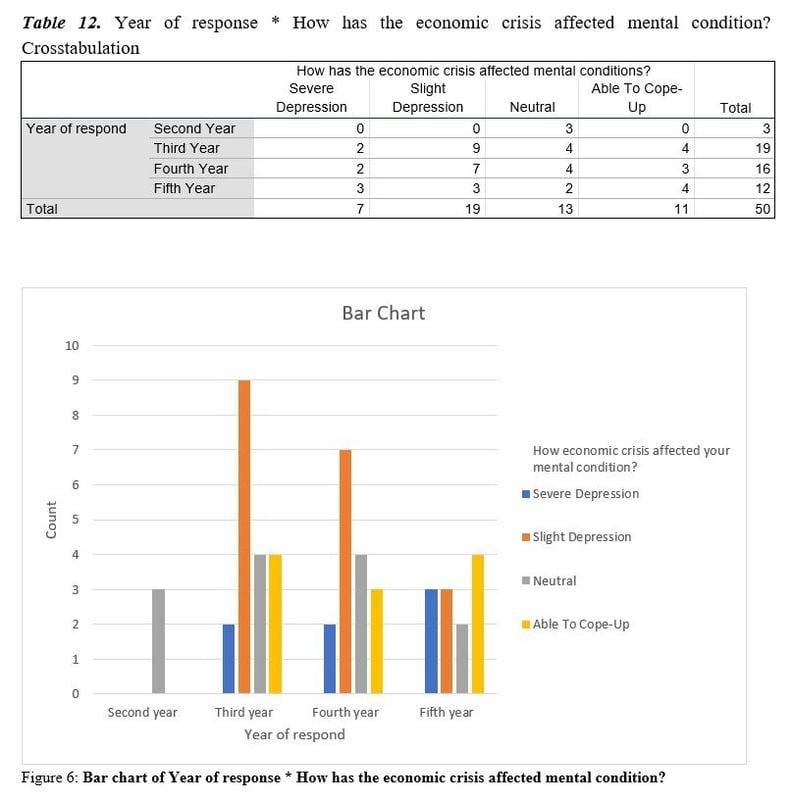

As can be seen from the correlation in Table 13, there is a significant correlation between the semester clutter and the session lag of students during Lockdown with Student Quality (which we get as * * Significant Value .447). On the other hand, no significant correlation was found between student quality and online class attendance. The reason behind that they have attended classes randomly despite their academic potential.
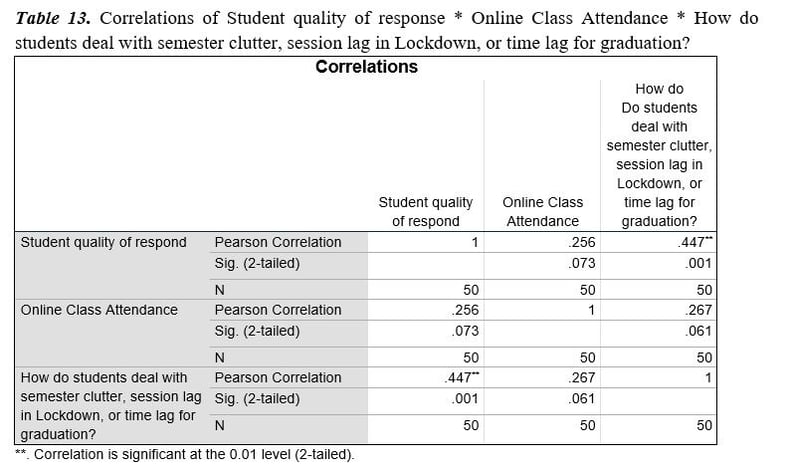

The correlation of Table 14 shows that the fear of being infected with the coronavirus has no significant correlation with their attitude change and physical health. One of the major problems teenagers faces is that they are less concerned about their health than their family members, and they have not changed their attitude significantly. This is because their perception of their immune system is higher than that of older people. Therefore, no significant correlation can be seen in the table.
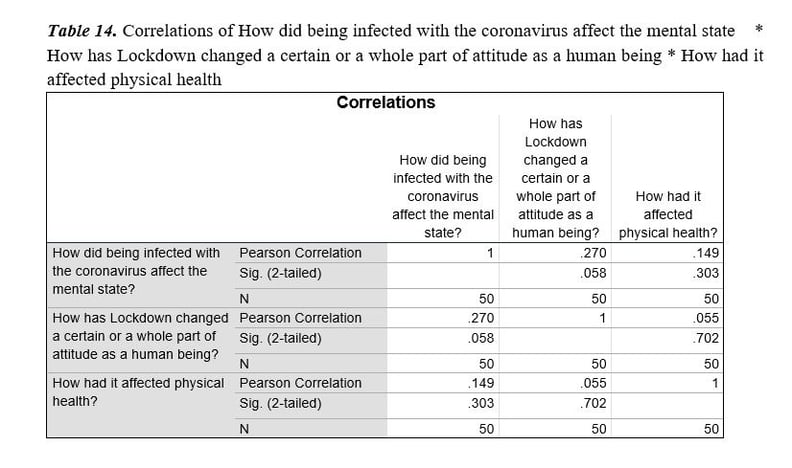

Chapter 5: Problem Analysis and Findings
The questionnaire survey allowed respondents to detail further any potential issues relating to online learning that the survey may not have covered. These things were discovered:
• Parents' scepticism about the value of online education.
• Preference for online learning with recorded audio.
• Constant interruptions from relatives.
• A lack of mobile devices that can connect to learning platforms online.
• Inability to purchase a computer on a budget.
• Decreases classmates' or peers' sense of emotional and social affiliation.
• Self- and environmental distractions (watching TV, visitors, leisure, sports, procrastination).
• Uncertain about lecturers' ability to teach effectively using online resources and platforms.
• Some technology advancements might be utilized for reasons other than those for which they were designed, opening up opportunities for cybercrime and raising privacy issues.
These difficulties have been revealed, and they serve as guidelines for proactive policies and initiatives to enhance online education in KUET's architectural schools and give information to other contexts and researchers.
5.1 Students' Opinion on Overcoming Corona Pandemic
As can be seen from Table 15, in order to overcome the problems created by the lockdown effect change, we have surveyed the next Corona. That is why we have taken yes and no choices through their various response through questionnaire surveys based on different positive criteria.
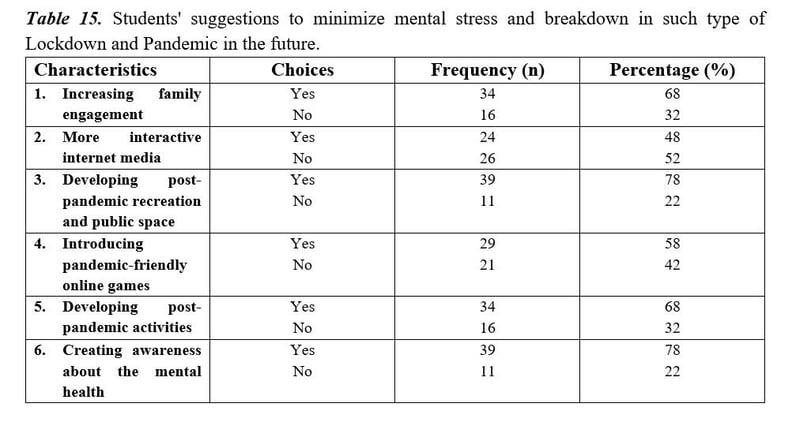

Chapter 6: Conclusion and Recommendation
Our findings indicated that KUET architecture students lacked knowledge of COVID-19 and high-risk perceptions. The pandemic had a detrimental effect on university students' mental health, indicating that we should enhance the regular instructional procedures that train students' mental fortitude. Additionally, associated medical centers should improve their ability to monitor campus-wide public health problems.
The study's findings also show that many participants desired additional direction and support since they felt unsure about various areas of their online learning experience. During the first Year, encouragement and clear direction were essential. Additionally, students could not manage their time and workload and relied on grades rather than their own ability to judge their learning and on their tutors to do the teaching for them.
The university authority, government, and NGOs should do the following:
1. Assure the implementation of self-help interventions.
2. Inform people of the probable psychological effects and responses to a lockdown situation.
3. Establish a dedicated platform to handle psychosocial problems.
4. Ensure that those experiencing severe problems can get the assistance they require.
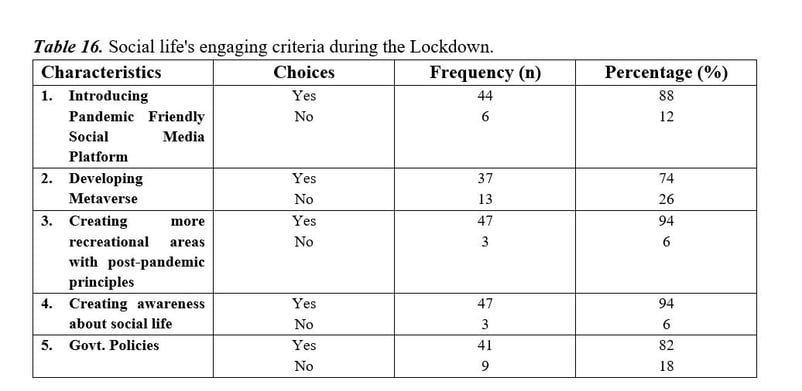

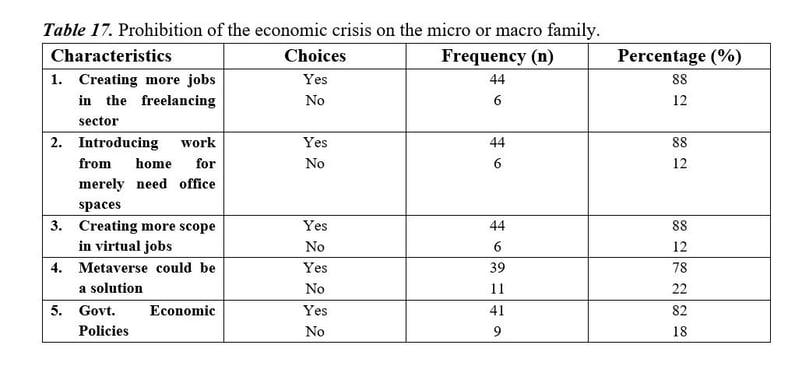


Meet The Author


Related Articles





